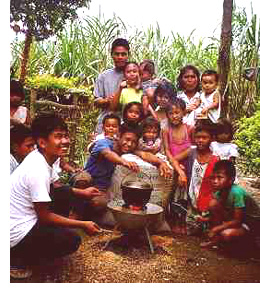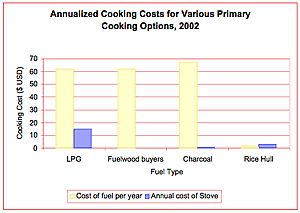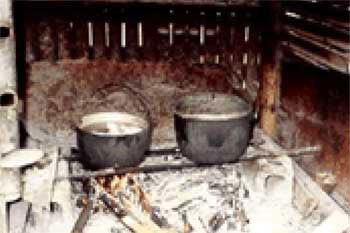Mayon Turbo Stove: Philippine Case Study
Reducing Poverty and Greenhouse Gas Emissions in the Philippines
|
MENU MTS Evolution MTS Design Package Phillippine Case Study Gambia Case Study Carbon Credits Online library |

|
 |
|---|
| More than 1.5 million tonnes of unwanted rice hulls are being discarded or burned in the Philippines |
A stove users study of 100 households in January 2002 in the upland areas of Negros Occidental found an improved rice hull stove (the LT-2000 ?|an enhanced version of the Lo Trau stove and forerunner to the MTS) dramatically reduced household cooking costs for impoverished families. The households in the survey had an average annual income of $756 USD and a per capita income of $126 USD. The stove was found to largely displace gathered and purchased fuelwood, as well as some charcoal and LPG use. On average, the introduction of a $7 USD (although the stove is currently being produced at $10 USD) rice hull stove reduced the annual fuel expenditures for cooking (fuel and firestarter costs) from $35.58 to $13.17 (De Maio et al., 2002). The annualized cost of owning the rice hull stove was estimated to be only $2.92. Additionally, the stove reduces the laborious task for women of fuelwood gathering, which typically requires 60-120 days per year of work in upland communities in Negros Occidental. The economic savings increased when the analysis projected the costs of stove users who were entirely purchasing their fuel supplies. Rice hull stove users were estimated to have annual cooking costs of only $4.87 USD per year compared to $61.98, $67.54 and $77.32 for cooking with purchased firewood, charcoal, and LPG respectively. The projected savings from 100% displacement of rice hulls for other purchased fuels represented 7.6?|9.6% of the total annual family income. For impoverished families suffering from malnutrition, these are critical household savings that can
 improve family income and wellbeing. The rice hull stove user survey found on average the LT-2000 stove had a 76% displacement of conventional fuel use in households. The average per household impact was to reduce the quantity of firewood, charcoal and LPG used by 1734 kg, 54 kg and 7.2 kg respectively per year. It was projected that a more advanced rice hull stove could increase market penetration by increasing user convenience, reducing rice hull consumption and increasing the conventional fuel substitution impact of the stove in individual households.
improve family income and wellbeing. The rice hull stove user survey found on average the LT-2000 stove had a 76% displacement of conventional fuel use in households. The average per household impact was to reduce the quantity of firewood, charcoal and LPG used by 1734 kg, 54 kg and 7.2 kg respectively per year. It was projected that a more advanced rice hull stove could increase market penetration by increasing user convenience, reducing rice hull consumption and increasing the conventional fuel substitution impact of the stove in individual households.
The Mayon Turbo Stove was developed by REAP-Canada in partnership with local workshop artisans in the Philippines in December 2001. It was designed as a low cost and clean-burning fuel stove to efficiently burn porous crop residues like rice hulls and coffee shells. Other available biomass residues like sawdust, corn cobs, peanuts shells and crushed coconut shells can also be mixed in with rice hull as a supplement.
 |
|---|
| Traditional biofuel cooking methods use 2 tonnes of firewood per year. |
Learn more about:
Additional information on the MTS can be found in the on-line library.




